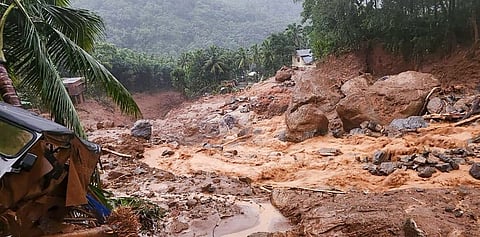
- Home
- Live Blog
- Breaking News
- Top Headlines
- Cities
- NE News
- Sentinel Media
- Sports
- Education
- Jobs

New Delhi: Kerala is once again in the news for an extreme weather event, as its Wayanad District reels from destruction wreaked by one of the most devastating landslides triggered by incessant monsoon rains. Experts point at reasons beyond the meteorological factors, such as climate change and unplanned development, for the catastrophic landslides. In the wee hours of July 30, multiple landlines swept away several villages in Wayanad. The tragedy has claimed over 200 lives and left 200 people missing.
Kerala receives the second-highest monsoon rainfall in India after the northeastern states. It records an average annual rainfall of about 3,107 mm of which 75 per cent is received during the monsoon months of June-September. Geographically, Kerala is bound by the Arabian Sea to its west and the Western Ghats to its east. This makes it highly susceptible to heavy rains during the season, say climate experts.
Orography has a strong effect on rainfall distribution in the mountainous region of Kerala. The rainfall potential of the region increases from the coastal belt towards the Western Ghats. It reaches maximum on the windward side of the Ghats and rapidly decreases on the leeward side.
The rainfall characteristics over Kerala are unique because of the influence of isolated steep-sloped structures separated by the wide Palghat gap.
Contrary to this climatology, the state has experienced severe floods in recent times due to intense precipitation during the monsoon season.
“Whilst rainfall in Kannur District has been 21 per cent above the average between June 1 and July 30, it is 14 per cent below the average in the neighbouring district of Wayanad, and up to 25 per cent below average in Idukki and Ernakulam districts,” said Akshay Deoras, Research Scientist, National Centre for Atmospheric Science and the Department of Meteorology, University of Reading, Britain.
“The co-occurrence of two extreme scenarios (landslides and rainfall deficit) in the same state reflect a strong spatial variability in this year’s monsoon rainfall. The expectation is that such a pattern would become more intense in the future if global warming continues,” he said. There has been a steady rise in extreme events in the state over the last decade. For example, Cyclone Ockhi wreaked havoc in 2017, followed by devastating floods in 2018, which were among the worst in the state’s history. In August 2019, the state experienced another spell of extremely heavy rainfall.
According to a report, ‘Climate Change Assessment over the Indian Region’, the inter-annual variability of summer monsoon rainfall is projected to increase throughout the 21st century.
The increased frequency of localised heavy rainfall on sub-daily and daily timescales has enhanced flood risks across India.
Numerous studies have established that the rise in global average temperatures due to human-induced climate change has led to an increase in the number of extreme rainfall events associated with monsoon, thunderstorms and short-spanned local cloudbursts.
These events, ranging from a few hours to a few days, have become more frequent in the recent decades over the subcontinent.
The effects of climate change have led to changes in monsoon trends due to the weakening of synoptic activity within the Indian monsoon and the moistening of the tropical troposphere.
“The meteorological factors behind extremely heavy rainfall include climate change as it is drastically changing rainfall patterns in Wayanad. What was once a cool, humid environment with year-round drizzles and monsoon rains, is turning into one marked by drier, hotter summers and intense downpours during the monsoons.
“This change has increased the risk of landslides. Dry soils absorb less water and heavy rainfalls cause run-offs that can lead to landslides, such as the ones we’ve seen this week,” said Mariam Zachariah, Research Associate, Imperial College London. Citing similar views, Mahesh Palawat, Vice-President, Meteorology and Climate Change, Skymet Weather, said, “Monsoon patterns have definitely changed and behave in an erratic manner. (IANS)
Also Watch: